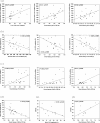Attenuated NoGo-related beta desynchronisation and synchronisation in Parkinson's disease revealed by magnetoencephalographic recording
- PMID: 31076640
- PMCID: PMC6510752
- DOI: 10.1038/s41598-019-43762-x
Attenuated NoGo-related beta desynchronisation and synchronisation in Parkinson's disease revealed by magnetoencephalographic recording
Abstract
Parkinson's disease (PD) is a neurodegenerative disorder characterised by motor abnormalities. Many non-demented patients with PD have cognitive impairment especially in executive functions. Using magnetoencephalographic (MEG) recording combined with event-related desynchronisation/synchronisation (ERD/ERS) analysis, we investigated cortical executive functions during a Go/NoGo task in PD patients and matched healthy subjects. PD patients had a longer reaction time in the Go condition and had a higher error ratio in both Go and NoGo conditions. The MEG analysis showed that the PD patients had a significant reduction in beta ERD during the NoGo condition and in beta ERS during both Go and NoGo conditions compared with the healthy subjects (all p < 0.05). Moreover, in the Go condition, the onsets of beta ERD and ERS were delayed in PD patients. Notably, NoGo ERS was negatively correlated with the Unified Parkinson's Disease Rating Scale (UPDRS) score in PD patients. The present study demonstrated abnormalities in motor programming, response inhibition, and frontal inhibitory modulation in PD. Further extensive investigations are necessary to confirm the longitudinal treatment responses in PD.
Conflict of interest statement
The authors declare that the research was conducted in the absence of any commercial or financial relationships that could be construed as a potential conflict of interest. Hung-Ming Wu, Fu-Jung Hsiao, Rou-Shayn Chen, Din-E Shan, Wan-Yu Hsu, Ming-Chang Chiang, Yung-Yang Lin report no disclosures. All authors declare no non-financial competing interests.
Figures





References
Publication types
MeSH terms
LinkOut - more resources
Full Text Sources
Medical

